Your organization’s internet connection underpins your network so having the best possible connectivity option is non-negotiable. If you’re still relying on outdated internet connectivity like copper cabling, your useful cloud solutions won’t give you any of the benefits you’ve paid to experience.
Fiber is the only choice for businesses looking to stay competitive in 2021 and beyond. There are three critical areas where fiber surpasses what you can get from traditional connectivity options: performance, reliability, and scalability.
1. Unmatched Performance
A slow internet connection can cost your employees one week per year of productivity. Now multiply that loss by 10, 20, or 100 employees and we’re talking about tens of thousands of dollars per year! Fiber is not only a high-speed internet service but is also high-performing. With fiber, you get direct access to an internet service provider as opposed to using a shared connection through legacy technology like cable that could slow down your connection.
Additionally, fiber is a low-latency technology. Bandwidth is how much information can be sent at once while latency is how quickly it gets there. When you’re downloading a lot of data, you want significant bandwidth, but for two-way communication, you want low latency. Just 150 milliseconds of latency — a delay of less than 2 tenths of second — can result in poor network performance. (Amazon found that every 100 milliseconds of latency cost them 1% in sales.) Fiber provides the low latency required to run mission-critical services seamlessly.
2. Reliability and the Bottom Line
Gartner reports a single hour of downtime costs over $100,000. Network outages have wiped out enterprises in one fell swoop. When daily operations rely heavily on the cloud, an outage that lasts even a few minutes can be a hit to your finances and reputation. Fiber provides the reliability you need to rest assured your business will stay online through damaging events.
Because copper cables use electrical signals to communicate, external factors such as inclement weather and electromagnetic interference are more likely to cause a loss of connectivity. Old or worn copper cable can even present a fire hazard because it carries an electric current.
Fiber doesn’t conduct electrical signals, so it’s less likely to go down – even in terrible weather conditions. Fiber is also more resistant to electromagnetic, corrosive, and lightning-related damage and is less likely to go down during a power outage. With 99.999% uptime, fiber is dramatically more reliable than older technologies.
3. Scalability
In 2020, businesses discovered exactly how rapidly stable situations could change. With more and more businesses of every size shifting toward convenient cloud-based solutions, you need a scalable connectivity option that allows you to quickly adapt to whatever unanticipated changes come your way.
Fiber networks are more scalable than any other connectivity method because fiber optic wavelengths can be turned on and off on demand – allowing for quick scaling. Additional fiber infrastructure can be placed in preparation for growth that’s planned years into the future whereas the average lifespan of legacy broadband such as copper is a little over five years. With fiber, when your business hits a period of expansion, you won’t find yourself scrambling to get the connectivity you need to meet your growing current demand.
Your Business Will Thrive With LS Networks Fiber
Keeping up with modern business technology – and your competitors – requires partnering with a trusted fiber provider like LS Networks. We’ll solve your connectivity problems with an ultra high-speed, scalable, reliable connectivity solution that will help you thrive – no matter how the business environment evolves. To get started with unmatched fiber connectivity in the Pacific Northwest, contact LS Networks today.







